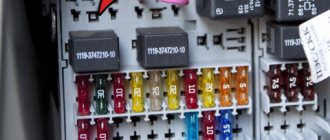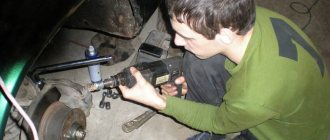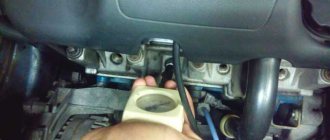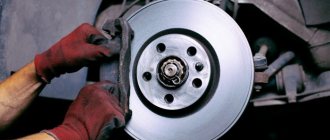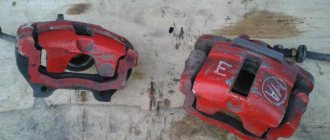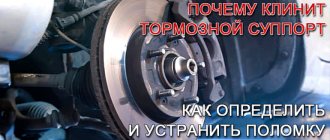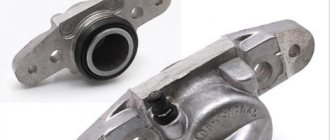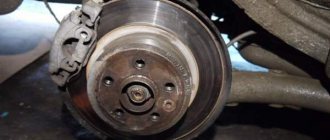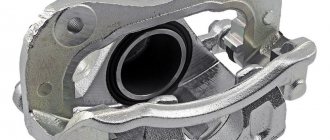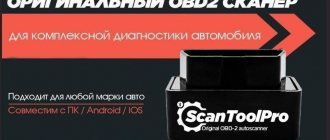What to do if the caliper creaks or jams
If the brake caliper creaks or jams, and the part is in good condition, you can try to fix the problems yourself.
To do this, it is recommended to perform the following set of actions: First of all, you need to unscrew the brake caliper; to do this, you need to put the car on a jack and remove the wheel. It is worth noting that in some car models the caliper can be unscrewed counterclockwise; Having removed the caliper, unscrew the piston using a wrench, then it must be pulled out of the cylinder; The removed parts must be carefully inspected for chips, rust, corrosion and various damages. If rust is found, it needs to be cleaned thoroughly.
When the calipers are heavily worn, problems may arise with cleaning the rust with improvised means; in such a situation, the part will need to be sanded;
After cleaning the caliper from rust, drain the liquid from it, remove the sealing ring and clean everything thoroughly, special attention should be paid to the place where the ring is attached; Next, all the parts need to be dried, filled with liquid, and the caliper put back together.
Important: When reassembling the caliper, pay special attention to the boot so as not to accidentally damage it. If there are cracks on the boot, be sure to replace it
What to do if the rear brakes are stuck: 4 working methods
1. A screwdriver will help.
We can say that a vehicle owner is lucky if the car is equipped with disc brakes. Then there will be no difficulties with unlocking when the rear brakes jam:
- The wheel is dismantled, and the frozen brake pads are separated from the working disc of the brake system using a flat screwdriver.
- Next, the disk rotates, which should rotate easily after release.
- If the disc spins, the wheel is put back, the car is removed from the jack, you can move on.
2. Wedging the rear drum brakes using a hammer.
If drum mechanisms are installed on the rear axle (they can be seen even on modern cars), you need to act differently. The difficulty with this method is that the rear drum pads are not as easy to reach as is the case with discs. But there is a way out:
- The immobilized wheel is removed using a hammer.
- The drum is tapped along its entire circumference.
- Then the drum is rotated, it should be released. If this happens, the wheel is put in place and you can drive.
The effectiveness of the hammer method is approximately 70%. But what if the hammer didn't help?
3. Load on the rear axle plus a sharp start.
To solve the problem in this case, you need to load the rear of the car. It would be best to fit three adults in the back seat. If those interested are found, they are seated in the cabin, the power unit is started, it is spun to high speeds and a sharp start is made.
If it didn’t work the first time, don’t be upset: sooner or later the rear brake pads will come off the brake disc. This can be determined by the characteristic knock of the pads coming off. Helping passengers leave the back seat of the car, and the driver sets off.
This outcome is possible for 20% of successful wedgings, but what to do with the remaining ten percent?
4. Using a blowtorch.
The rear wheel is dismantled, the brake drum is thoroughly warmed up using a blowtorch. The main thing now is to distribute the heating as evenly as possible over the entire area of the drum. Otherwise, the brake cuffs will fail. You should work with a soldering iron until a characteristic click is heard, which means that due to heating, the drum has expanded and the brake pads have “come unstuck” from it. The wheel is put in place, after which you need to try to spin it. If everything went well, the car can continue moving.
What actions need to be taken so as not to be puzzled in the future by the question of why the rear brakes are sticking?
There are two rules:
- Do not put the car on the handbrake when parking for a long time.
- If the vehicle has driven into a puddle and the brake pads are wet, you need to dry them so that the rear brakes do not jam in the future. To do this, you need to press the brake pedal several times while driving and only then drive the vehicle into the parking lot.
“Repairing disc brakes: nuances and advice from professionals”
Design and purpose of the brake caliper on the VAZ 2107
To understand why the “seven” needs a brake caliper, you should clearly understand how the brake system of this car is designed. First of all, it should be said that the VAZ 2107 has two brake systems: parking and working. The parking system allows you to lock the rear wheels after stopping the car. The working system allows you to smoothly block the rotation of the front wheels while the machine is moving, changing its speed until it comes to a complete stop. A hydraulic braking system consisting of four cylinders, two brake discs, four pads and two brake calipers allows you to achieve smooth blocking of the front wheels.
Brake calipers are installed only on the front axle of the “seven”. On the rear axle there are brake drums with internal pads
The brake caliper is a housing with a pair of holes, made of light alloy. Hydraulic cylinders with pistons are installed in the holes. When the driver presses the pedal, brake fluid is pumped into the cylinders. The pistons from the cylinders extend and press on the brake pads, which in turn compress the brake disc, preventing it from rotating. This changes the speed of the car. Thus, the caliper body is the basis of the VAZ 2107 working brake system, without which the installation of brake cylinders and discs would be impossible. It should also be noted here that brake calipers are installed only on the front axle of the VAZ 2107.
Caliper VAZ 2107. Arrows show the location of the hydraulic cylinders
As for the parking system of the VAZ 2107, it is designed differently. Its basis is large brake drums with internal pads installed on the rear axle of the car. When the driver, after stopping the car, pulls the handbrake lever, the brake pads move apart and rest against the inner walls of the drum, completely blocking the rotation of the rear wheels.
The design of the rear brake drum is significantly different from the hydraulic brakes on the front wheels.
Signs of a faulty brake caliper
There are not many signs of malfunction in the VAZ 2107 brake caliper. Here they are:
- The car does not brake fast enough. This usually occurs due to a brake fluid leak. It can escape either through worn hoses or through hydraulic cylinders that have lost their tightness due to wear. The first version of the problem is solved by replacing the brake hoses, the second - by replacing the damaged cylinder;
- constant braking. It looks like this: the driver, pressing the brakes, stopped the car, and when he released the brake pedal, he discovered that the front wheels remained blocked. This happens because the cylinder pistons are stuck in the open position and the brake pads are still pressing on the brake disc, holding it in place. In such a situation, they usually change the entire caliper, since finding new hydraulic cylinders for the “seven” on sale becomes more and more difficult every year;
- squeaking noise when braking. The driver, pressing the brake pedal, hears a quiet squeak, which can intensify with increasing pressure. If you have to brake sharply and at high speed, the creaking turns into a piercing howl. All this suggests that the brake pads in the caliper have completely worn out, or rather, the coating of these pads. The material that covers the front part of the block has increased wear resistance, however, it eventually becomes unusable, being worn down to the ground. As a result, the brake disc is compressed by two steel plates without a protective coating, which leads not only to a loud squeaking sound, but also to increased heating of the caliper.
Tubes and hoses
Brake pipes and hoses of the braking system of the VAZ “kopek” are used both front and rear. Their purpose is to connect the GTZ and RTC to each other and supply brake fluid to them. Sometimes connecting elements become unusable, especially hoses, due to aging rubber.
Damage to the hose leads to fluid leakage and depressurization of the brake system.
The parts in question are attached using a threaded connection. There are no difficulties in replacing them. You just need to unscrew the fasteners on both sides, remove the worn element and install a new one in its place.
Causes of jamming and creaking
Now directly about how to determine the presence of a problem.
The primary sign indicating a malfunction in the calipers of a car brake system is squeaking.
It is the creaking that indicates that the element is seriously worn out. In the near future, the unit must be replaced without fail, which the car literally and figuratively screams about. It is extremely difficult not to hear such a creak. But for some reason, thousands of motorists still stubbornly ignore it. As a result, they pay a rather high price. Sometimes even to the point of road accidents resulting from brake failure while driving. To prevent this, you need to understand the issue and understand the essence of what is happening.
The first step is to look at the possible causes. In fact, there are several potential problems to look for. Some of them arise due to the fault of the motorist, others are caused by the natural process of wear and tear.
In any case, the appearance of a squeak as a symptom is a harbinger that at the most inopportune moment the caliper may simply jam.
If you know the reasons, you can prevent them and troubleshoot them by contacting a car service center or solving the problem yourself.
The reasons are:
- The brake pads were initially installed incorrectly. As a result, they are not strictly parallel to the response drives. Because of this, creaking often appears;
- The brake discs are seriously worn out. The reasons are natural wear and tear and aggressive use of the car;
- There is no lubrication in the unit. Initially there was little of it, or it was used up;
- The lubricant was selected incorrectly. Many people skimp on lubricant intended for calipers, hence the consequences.
The most undesirable and dangerous situation is rightly considered when the piston does not return and the unit begins to jam during operation.
Imagine that you are driving a car, press the brake, and then accelerate again. But at the same time, the calipers do not release the front brakes. Additional resistance arises, the car tries to move, but cannot. The result is uncontrolled braking, extremely intense wear and serious overheating of the entire system.
Both wheels won't release
The caliper is stuck. The diagnosis is sad, because this did not just happen, but had been accumulating for some time. So, most likely, you will have to change not only it, but also the pads - during the abnormal operation they have probably been worn down to zero. The costs will be significant, but you can save money if you can change it yourself. However, everything may not be so sad: the caliper may be intact, but skewed. In this case, the position is leveled out and the wheels begin to release the brakes again.
The compensation hole on the brake master cylinder is clogged. There is a lot of fuss, the work is dirty, you will have to disassemble almost the entire assembly, but there are no expenses for spare parts. Read the article “How to check and bleed the master brake cylinder” for more details.
Pistons and wheel brakes are jammed
, and the master cylinder. Only those who regularly delve into their cars will be able to find out the reason on their own. Sound advice is to go to a service center and only after finding out the cause decide whether you can fix it or let the experts repair it. Often the problem is solved by cleaning and lubrication.
Be sure to check all hoses
. It is not uncommon for the clamp that secures the hose to corrode and compress it. If this reason is suspected, the clamp should be released (and ideally replaced) and the hose itself should be blown out.
Rear wheel jams: we'll deal with the situation
10/14/2019 Issues discussed in the material:
- What to do if the rear wheel is stuck
- How to determine the cause of the problem
- Why, according to car enthusiasts, can the rear wheel suddenly jam?
Some motorists experience rear wheel jamming that occurs suddenly. And it’s good if the car is just starting to move. However, it is possible that the problem may arise while driving on the highway. This situation is highly likely to provoke an accident. What are the main reasons that lead to the rear wheel jamming? What should I do to successfully fix this problem? Let's look at these questions in this article.
Replacing the brake cylinder boot (prevention of brake pads)
I had a free day to repair the caliper (when I was changing the pads, I saw a crack in the boot). We ordered repair kits for all 4 calipers, installed only the front ones (it takes a lot of time to assemble/disassemble). The process itself is not complicated, the main thing is to do it consistently and not forget to put anything in its place.
Front caliper repair kit 4605A259
Rear caliper repair kit 4605A262
1. Pull off the wheel by hanging the car on a jack
2. Unscrew the lower and upper guides of the caliper (mine were sour, WD helped)
3
We unscrew the brake fluid supply hose to the caliper (pay attention to the copper washer, you can see in the photo, you cannot lose it, the same one is located between the hose fitting and the clamping bolt). 4
We pull out the cylinder (I did not use any adapters to pump pressure into the caliper, etc., I carefully grabbed the piston and began to pull, slowly, with tension, but it came out)
4. Pull out the cylinder (I did not use any adapters to pump pressure into the caliper, etc., I carefully grabbed the piston and began to pull, slowly, with tension, but it came out)
5. Next, we remove the old boot and the O-ring, the ring is located inside the brake cylinder, it has its own seat, we pick it carefully so as not to leave any nicks
6. Clean the piston and cylinder (I cleaned it with carb cleaner)
7. We take out the repair kit, take the rubber seal and boot.
8. Lubricate the sealing ring with grease from the bag (red) and place it in its seat.
9. Apply the same lubricant to the cylinder walls and the piston itself
10. We insert the piston back, making sure that it does not pull the rubber sealing ring inward.
11. Take the boot, turn it inside out and apply grease to its inner side
12. We put it in its place, or rather “press it in” (it took me about 5 minutes for him to sit down, he constantly tries to jump out)
This completes the main part. The repair kit still contains the caliper guide anthers and the rubber band for the lower finger; we also lubricate them and put them in their places, having first removed the old ones and cleaned the mounting holes of the fingers from the dirt of the old grease.
13. Take the caliper ready for installation, screw on the brake fluid supply hose (don’t forget about the copper washers)
14. Lubricate the guides (only high-temperature lubricants!) Put the caliper in its place, screw in only the top finger, after installing the pads, screw in the lower finger
15. Tightening torque of the fingers - there is no need to pull all the way, otherwise souring and breakage of the thread will inevitably occur.
Next, we take the pads, lubricate all their installation connections, anti-squeak plates, install them, lower the caliper (the upper finger holds it), screw the lower finger into place.
Next, you need to bleed the system, I forgot to unplug the terminal from the battery, so the ABS error came out, but after I drove along the highway and braked until it triggered, it disappeared.
PS: When the fluid supply hose is unscrewed, the brake fluid begins to flow out, and not just flow out, but imperceptibly and very quickly, it seemed like droplets, but no, ALL of it flowed out!
The hole in the hose fitting is very small, I don’t even know what to plug it with. I decided for myself that repair of calipers should be done with replacement of brake fluid (it won’t be superfluous)
After bleeding the entire system, you definitely need to bleed the clutch; it is fed from the same tank.
Sequence of actions when replacing rear pads
Preparatory stage: a set of automotive tools, rags, liquid for removing deposits, a new parking brake cable, graphite-based lubricant.
We install the car on the inspection hole, fix the front wheels with wheel chocks, remove the rear wheel; Underneath the bottom, we unscrew (loosen) the handbrake cable for the convenience of carrying out maintenance work; Gently tap the drum guide bolts with a hammer. During operation, installation/disassembly, the bolts stick and are difficult to unscrew
If tapping does not help, spray with liquid to remove deposits, wait 10 minutes, then start unscrewing; After removing the drum cover, pay attention to the position of the parking brake lever. If it is not located near the lever, it means it is bitten and must be replaced
If you ignore this signal, it will be problematic to install the drum in its normal position; Remove the upper pressure spring, press the strut support, and turn it until it completely coincides with the slot. Remove the two cups and the spring from the stand; Disconnect the cable shank from the handbrake lever. We clean the disc from dirt, deposits, and rust; We carry out troubleshooting of the brake cylinder and seals. If there are signs of wear, leakage, or deformation, replace it with a new repair kit; We remove the parking brake lever from the old pads, take out the cotter pin and washer; Please note that the left and right levers are different and not interchangeable. Next, you need to install a spacer bar and move the pads apart. When installed correctly, the lugs are vertical; We start a new cable, fix it in the eye; We install new pads and assemble the structure in reverse order. If you have any difficulties with installation, it is better to watch the video presented in this manual.
The final stage: adjusting and tensioning the handbrake lever. In accordance with the requirements of the instruction manual, the handbrake should clamp the pads already at 5–6 clicks. Exceeding the norm indicates weakening, and decreasing indicates excessive tension.
Prevention measures
I can say from personal experience that the detailed cleaning procedure is quite complicated. This will definitely take more than one hour.
To minimize the number of repetitions of such operations, be sure to lubricate the caliper twice a year for preventive purposes. It is optimal to use professional special lubricants designed specifically for this element. But regular WD40 is also an alternative. It will definitely protect against corrosion.
Plus, visually inspect the condition once a year. Make sure that the assembly is free of damage, dirt and signs of corrosion. Make sure that the boot does not rupture during operation. Otherwise, the caliper will not last long after this.
You need to monitor all brake systems, including periodic adjustment of the handbrake. After all, this is also an integral part of vehicle safety.
Subscribe, leave reviews, tell your friends about our project!
Watch this video on YouTube
Important points
When repairing the brake system of a VAZ 2107, you should remember several very important nuances. Without mentioning them, this article would be incomplete. So:
- On later VAZ 2107 models, spring washers began to be installed under the fastening bolts of the brake brackets. They are thin and very easy to lose when removing the bracket. To prevent this from happening, it is advisable to spread some newspaper or rag under the caliper. If the puck does pop out, it will be much easier to find it;
- If the driver does not plan to change the brake pads when replacing the caliper, then before removing them they should be marked with a marker or chalk so that they can be installed in the same place during reassembly. If you change the original location of the pads, they will become unusable much faster;
- If the driver decides to leave the caliper in place and plans to change only the brake pads, then he will have to buy not one, but two sets of pads, since these parts are always changed on two wheels, and not on one. If you leave old pads on one of the wheels, this will inevitably lead to rapid wear and new problems in the operation of the brake system;
- After removing the pads, do not press the brake pedal under any circumstances. The pistons on the hydraulic cylinders mounted in the caliper will move outward and prevent the installation of a new pair of pads. But pushing the pistons back will be very difficult: in some cases, this requires completely draining the brake fluid from the system;
- When unscrewing the fastening bolts on the caliper, you should remember: they differ in the shape of the head. The head of the top bolt is smaller, the head of the bottom bolt is larger (in the photo it is marked with the letter “a”). If the bolts are swapped, it will be impossible to install the brake pads;
- When buying a new caliper in a store, you should definitely tell the seller which side it will be installed on, since on the VAZ 2107 there are differences in the design of the left and right calipers. For example, the holes for the mounting bolts are located differently, so that the left caliper will not fit the right wheel and vice versa;
- Finally, after installing the caliper, you should be sure to press the brake pedal several times to check whether the new caliper works or not. In addition, after pressing the pedal, be sure to inspect the caliper and the asphalt under the car for brake fluid leaks.
So, replacing a brake caliper is not as difficult a task as it might seem at first glance
The main thing that the driver should remember when changing this part is its extreme importance. If a mistake is made when installing the caliper or pads, this does not bode well for either the driver or the car.
It is for this reason that the article described in as much detail as possible all the nuances of installing a brake caliper.
And it is strongly recommended that you pay close attention to these nuances.
Where in St. Petersburg to check the serviceability of the parking brake
Our auto centers will quickly and efficiently check the serviceability of the parking brake in a Citroen or any other car. The company has been operating on the market for more than 20 years, providing high-quality services for maintenance and repair of Citroen, as well as cars of all brands and any year of manufacture at affordable prices. Our service stations have the latest equipment and are equipped with special tools, and our employees are highly qualified.
You can get more detailed information on our website or find out directly from managers. We will be glad to see you at our service center!
Why does the brake caliper squeak and jam?
A signal that there are problems with a car caliper is a squeaking sound. It may indicate that the caliper is worn out and needs to be replaced, or that a part needs diagnostic maintenance. The squeaking sound when calipers operate most often occurs for one of the following reasons:
The situation is critical when the brake caliper not only creaks, but jams during operation. In other words, the driver presses the brake pedal, and when it is released, the caliper does not remove the pads from the brake discs, which leads to uncontrolled braking of the car, excessive wear and overheating of parts in the brake mechanism.
Removing the front wheel caliper
In most cases, the front brake caliper must be removed when replacing the front wheel wheel cylinders.
Therefore, in this article we will consider in more detail how to perform this procedure. First of all, I will give a list of tools that will be needed for this repair of the VAZ 2106. So, we will need:
- 14 socket wrench or open-end wrench
- Flat screwdriver
- Ratchet handle
- Head 17
- Wrench with extension
2 more reasons why rear brakes stick
Rear brakes jam like this: the pads stick to the brake discs or drums, as a result the wheels do not rotate and the vehicle does not move.
Why do the rear brakes stick? There may be two reasons:
- The car “rested” on the handbrake for more than a month.
- The brake pads got wet when the vehicle got into a puddle, and the driver drove the car into a garage or parking lot without drying them.
You will have to be quite nervous in such circumstances. The rear brakes are jammed, there is no way to even get to the service station. You'll have to do the repairs yourself. Below are tips on how to deal with this situation.
How to clean a brake caliper
If the brake caliper is in good condition, but squeaks or jams, you can try to deal with the problems yourself. The algorithm of actions is as follows:
First you need to unscrew the rear brake caliper, for which the car is placed on a jack and the wheel is removed. It should be remembered that in some models the rear caliper can be unscrewed counterclockwise. After removing the rear caliper, use a wrench to unscrew the piston, then pull it out of the cylinder. The removed parts are carefully inspected for chips, rust, corrosion and other damage. If there is rust, it needs to be cleaned well.
If the rear calipers are heavily worn, it can be difficult to clean the rust with improvised means; then it is better to sand the part. Having rid the rear caliper of rust, you need to drain the liquid from it, remove the O-ring and clean everything thoroughly, paying special attention to the place where the ring is attached. Then you need to dry all the parts, add fluid and reassemble the rear caliper.
Important: when reassembling the caliper, you should handle the boot carefully so as not to accidentally damage it. If cracks are found on the boot, it must be replaced
These manipulations to completely clean the rear caliper are quite complex and can take a lot of time. To carry out such procedures as rarely as possible, every 6 months it is necessary to apply a special lubricant or WD-40 to the surface of the rear caliper to prevent corrosion.
You should also inspect the rear caliper every year to see if there is any corrosion, damage, dirt on it, or if the boot is damaged.
How does a brake caliper work?
In ideal condition, the brake caliper should operate as follows:
- The driver inside the car presses the brake pedal;
- At this moment, pressure is built up inside the brake line and it is transmitted to the piston group of all calipers;
- The calipers, under the influence of pressure, bring the brake pads to the disc mounted directly on the rotating wheel;
- Due to the frictional force that arises, the rotation of the disk, and at the same time the wheel, slows down.
Important: for proper operation of the brake system, the pads must be positioned strictly parallel to the brake disc. Because friction occurs when a vehicle brakes, it also generates heat, which warms the brake pads, fluid, and calipers.
Accordingly, a working brake caliper must consist of a material whose properties do not change when heated. Also, the caliper material must be strong to withstand heavy loads.
Because friction occurs when a vehicle brakes, it also generates heat, which warms the brake pads, fluid, and calipers. Accordingly, a working brake caliper must consist of a material whose properties do not change when heated. Also, the caliper material must be strong to withstand heavy loads.
Bleeding the brake system of VAZ 2106
Bleeding the brakes is done to remove air trapped in the brake system. It is easy to determine the presence of air: the brake pedal is initially pressed too softly, and after several presses it suddenly acquires an unusual “hardness”. These are signs of an air lock.
Sequencing
First of all, it should be said that it is best to bleed the brakes with an assistant. But with some skill, this can be done alone.
- First, check the brake fluid level. The tank must be filled to the upper marks.
How to turn an inoperative brake cylinder piston into a functional one?
1) At the very beginning of the operation, you will need to remove the wheel from the car.
Note! By the way, when you remove the wheel from the car, try to spin it while it is in the air; if it slows down, then some piston has actually become unusable!
2) After your wheel is removed, immediately remove the caliper from the car after it in order to get out the brake piston that is not working. (For information on how to remove a brake caliper on front-wheel drive cars, see the article: “”, and for information on how to remove this caliper on a classic, see “”)
3) Now, when the caliper is removed from the car, you will need to find a vice, or a very strong compressor, in order to remove the piston from the brake cylinder, so if you have a vice, then go to it and clamp the piston itself and behind the caliper after Once you clamp the piston, pull it, and thereby the piston will be removed from its installation location.
Note! If you don’t have a vice, then pick up a compressor or something else where air can come out under pressure and thereby insert the hose from the compressor into the small hole in the caliper, namely where you connect the brake hose itself and then turn on the compressor and the piston will fly out of its installation location!
4) Next, take the removed piston in your hands and inspect it, if you find traces of rust on it as shown by the arrow in the photo below, then they will have to be removed using some kind of chemical or something else (A good example of cleaning the piston from rust, shown in one of the videos below), and after the rust has been removed, also inspect the brake caliper itself and finally reassemble all previously removed parts in the reverse order of removal and at the very end check their functionality.
Note! Still, a new piston is not too expensive in the store for our domestic cars, so if you have the opportunity, then it’s better to replace it with a new one and throw away the old one, because who knows after how long it will start to rot again, maybe it won’t even last for a week will last and thus you will again have to disassemble the entire brake system, and by the way, if the boot on it is torn, then you will definitely need to replace such a piston with a new one, since dirt has already got into the inner part and it is unlikely to be able to get it out, yes Moreover, there will still be lubricant there, so as they say, decide for yourself to repair the piston or replace it with a new one!
Additional video: If you want to know how to remove the piston from the brake cylinder on front-wheel drive cars using the VAZ 2109 as an example, then watch the video below, which explains all this in detail:
How to easily and safely replace the steering wheel?
The operation of replacing the steering wheel is not particularly difficult, but safety precautions must be observed. The basic steps on how to remove the steering wheel have been described above, but in some cases the following tips may be needed:
Method #1. If the steering wheel sits firmly on the shaft and cannot be removed, then it is necessary to loosen the steering wheel nut as much as possible, but leave it one turn (to protect the teeth, nose and other parts of the face). Then sit in a chair and sharply and evenly hit the steering wheel with your palms from below, upward along the steering axis. After several such impacts, the steering wheel should fly off the shaft.
The main thing is to remember to leave the nut on one turn!
Method #2. To remove the steering wheel, you can use an old Zhiguli jack. The base of the jack needs to be rested against the steering shaft through a wooden spacer, wrap a rope around the steering wheel and throw it over the top of the jack. A piece of cloth (rag) should be placed at the point where the rope comes into contact with the steering wheel so as not to scratch the steering wheel. Next, gradually pull with a jack and remove the steering wheel. Do not forget to completely unscrew the steering wheel fastening nut, since in this case the steering wheel itself will gently “come off” from the shaft.
Express caliper repair
To resolve this issue, you need to follow the steps below.
- To begin the main work, you need to unscrew the caliper by turning it clockwise. If the part does not turn, you can try turning it in the other direction - in some cars the caliper is unscrewed counterclockwise;
- The next step is to unscrew the piston. To do this we use a key. After the part is unscrewed, it can be removed from the cylinder;
- When all the necessary elements are unscrewed, they must be checked for corrosion. Areas where there is rust should be thoroughly cleaned. It is better to sand difficult areas;
- After fighting rust, you need to drain the fluid from the caliper. We hope there is no need to explain how to do this;
- As soon as the liquid is drained, remove the O-ring and thoroughly clean it. We also clean the place where the ring is attached. Finally, dry each part thoroughly. To do this, you can use a hairdryer or resort to natural drying. The latter is possible if you have a lot of extra time.
If all the above steps have been carried out, then all that remains is to grind the inner surface of the cylinder itself. Here we do everything without fanaticism
, the main thing is to remove dirt and rust.
Once grinding is complete, you can add brake fluid and return the rubber ring to its place.
Now the clean piston is inserted back. It is inserted under pressure, as it needs to go through the o-ring
During this procedure, special care should be taken with the boot - the main thing is not to damage it
As mentioned above, the piston can be unscrewed both clockwise and counterclockwise. Therefore, this fact must be taken into account when screwing it in.
To keep the internal thread as close to the piston as possible, you just need to squeeze the handbrake flag.
Thanks to all the manipulations described above, you can successfully repair the caliper and get rid of its jamming.
Front brake repair
Repair of the front brakes should begin with an inspection; first of all, we try to turn the hub by hand; if the cylinders are not jammed, then you will succeed. Next, you can remove the brake pads; to do this, remove the corkscrews and take out the guide pins.
Removing the brake pads
After pulling out the fingers, we try to push the brake cylinder inside using a screwdriver; if you succeed, then the cylinder is in normal working condition and if there are no leaks and the boot is intact, there is no need to go in there. If the cylinders do not yield under the force of a screwdriver, then they need to be repaired or replaced, and I had such a situation.
The boot is torn, the cylinder is jammed
We see how the pads are worn unevenly:
Unevenly worn brake pads
If it is necessary to repair the brake cylinder, then you need to unscrew the hose and remove the caliper by unscrewing two bolts with a “17” key
Once removed, you must carefully knock the brake cylinder out of the caliper. This must be done carefully, since alloy cylinder bodies are prone to cracks.
I knock the cylinders out of the caliper through a piece of wood.
After the cylinder is removed, it must be cleaned of dirt.
Next, you need to remove the piston from the brake cylinder, this can be done using a compressor, pumping pressure into the cylinder (do this very carefully!), I used a wheel wrench
The cylinder is knocked out of the caliper
Cylinder without boot
We remove the piston from the brake cylinder of the VAZ 2101
Piston removed, sea of dirt inside
The pistons were removed, but despite all efforts one cylinder had to be replaced with a new one
After removing the pistons from the cylinders, we wash and clean the brake cylinders from dirt, especially paying attention to the cleanliness of the groove under the sealing ring inside the cylinder; it is often forgotten by oxide from the duralumin cylinder and the piston jams. After everything is cleaned, insert a new o-ring, be sure to lubricate it with clean brake fluid and insert the piston into place
Next, put on a new boot and insert the cylinder into the caliper.
Next, you can put the caliper on the car and secure it by tightening the fasteners well; in the factory version of the caliper mounting, there are locking washers under the mounting screws, which will also not be superfluous. Next, you can install the new pads in place and screw on the brake hose.
It is very important that when installing new brake hoses, install new brass O-rings under the hose. If these are included with the hoses, this is very good; if they are not, then be sure to purchase them, since they are practically disposable and new rings contribute to a reliable seal
At this point, the repair of the front brakes of the VAZ 2101 can be considered complete.
Features of work
First, let's try to imagine the ideal operation of a caliper as part of a car's braking system.
In fact, this is a mandatory component of any car, be it:
Regardless of whether it is installed on a Niva or a BMW, the caliper must be in constant working order.
This is the direct task of the car owner himself. Or persons responsible for maintaining the machine and maintaining it in proper technical condition.
Before determining why it does not press out and what to do to prevent the car caliper from jamming, you need to understand the principle of its operation.
In optimal condition, when the brake assembly is working properly, the operating diagram looks like this:
- the driver presses the brake pedal;
- pressure is built up inside the braking system;
- this pressure is transmitted to the piston group of the auto calipers;
- the calipers, being under high pressure, bring the brake pads to the disc;
- the braking disc is attached to the car wheel;
- friction force arises;
- wheel rotation slows down;
- the car stops;
- or reduces the speed to the required values.
As you can see, in theory there is nothing complicated. But in fact, the caliper is rightly called an extremely complex element.
Friction during active braking causes heat production. This heats up the pad, brake fluid and our caliper.
Therefore, it is extremely necessary that the car caliper be made on the basis of a material that does not change its properties and characteristics during the process of strong heating. Plus, there are increased requirements for strength.
Wheel bearing: 4 simple ways to check before it’s too late - Advice from experts
Many people know that there are certain bearings in the wheel area called wheel bearings, and from time to time they wear out. But this is where the ideas about the subject end. No problem! Today we’ll talk in detail about what it is and, most importantly, how to determine the need for replacement. And first, a little theory.
Without abstruse definitions, a wheel bearing is a bearing on which the wheel rotates. Of course, we all removed the wheels (or at least were present at this sacrament) and saw that there were no bearings on the wheel itself, and they were also not visible on the one from which they were removed. Right. Because this bearing stands between the fixed axis of rotation and what the wheel is screwed to . The part that acts as a fixed axis is called a fist
or
trunnion
.
A small clarification: the concept of “axis” in this case is used precisely as the geometric axis of rotation, and not as the shape of the part. For example, in the steering knuckles of a front-wheel drive car, this axis is hollow, and the drive shaft passes inside it. See pictures below.
In turn, the part to which the wheel rim is directly attached is called the hub.
. Thus, if you strain your head a little and imagine everything written above, then the following picture emerges: a bearing is put on the fixed axle (or inserted into it, if there is a drive), and a hub is put on the bearing, to which the wheel is screwed. This is such a simple nesting doll. Now about malfunctions and self-diagnosis.
